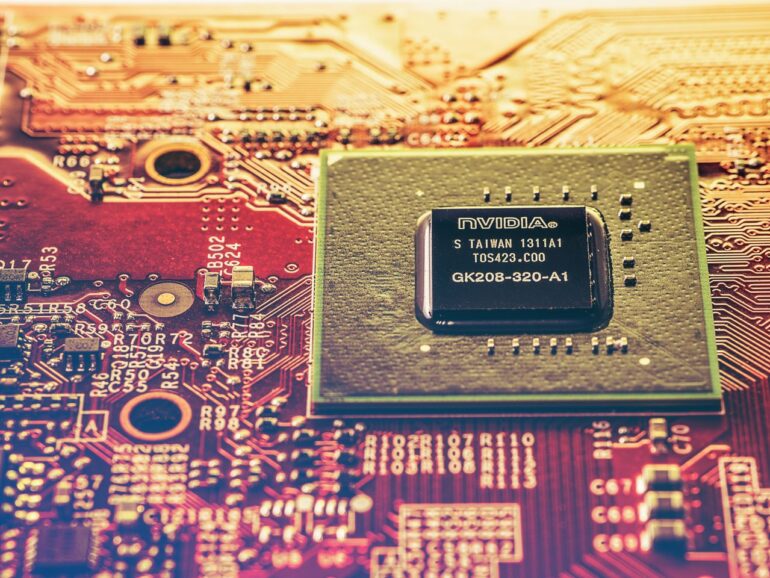TL;DR:
- AI chips, specialized computing hardware, have emerged as a crucial component in the AI revolution.
- Nvidia, the leading designer of AI chips, has experienced a surge in stock value and market capitalization.
- AI chips are designed to handle AI workloads and accelerate the training of AI systems.
- The origins of AI chips can be traced back to Nvidia’s development of the graphics processing unit (GPU) for video games.
- Nvidia dominates the AI chip market, with their latest product, the H100 GPU, packing in 80 billion transistors.
- Nvidia relies on Asian chip foundries for chip fabrication.
- Cloud-computing services like Amazon and Microsoft are major customers for AI chips, enabling smaller companies to access AI computing power.
- AI chips have applications beyond AI, with parallel processing being utilized in diverse domains.
- Nvidia faces potential competition from Advanced Micro Devices (AMD) in the AI chip market.
Main AI News:
In the rapidly evolving landscape of technology, a small and inconspicuous slice of silicon has emerged as a game-changer. Artificial intelligence (AI) chips, closely related to the graphics processors powering video games, have taken center stage, igniting what experts believe to be an AI revolution with far-reaching implications for the world. This sudden surge in demand has catapulted companies like Nvidia, the leading AI chip designer, into the spotlight, with their stocks soaring by nearly 25% and their market value briefly surpassing $1 trillion.
But what exactly are AI chips? Defining them is no easy task. According to Hannah Dohmen, a research analyst at the Center for Security and Emerging Technology, there is no universally agreed-upon definition. Broadly speaking, AI chips refer to specialized computing hardware designed to handle the demanding workloads of AI systems. These chips excel at training AI models and tackling complex problems that traditional computers find overwhelming.
The origins of AI chips can be traced back to the world of video games. In 1993, Nvidia was founded by three visionary entrepreneurs aiming to push the boundaries of computational graphics. Within a few years, they introduced a revolutionary chip known as the graphics processing unit (GPU). By leveraging parallel processing, this GPU accelerated both the development and gameplay experience of video games by performing multiple intricate graphics calculations simultaneously.
Little did they know that this breakthrough would have a profound impact on AI. In 2012, two graduate students from the University of Toronto harnessed the power of a GPU-based neural network to win the prestigious ImageNet AI competition. Their achievement generated significant interest in parallel processing for AI applications, presenting Nvidia and its competitors with new business opportunities and equipping researchers with formidable tools to advance the frontiers of AI development.
Today, Nvidia reigns as the dominant supplier of AI chips, providing the building blocks for constructing and enhancing AI systems. Their latest offering, the H100 GPU, boasts an impressive 80 billion transistors—13 million more than Apple’s cutting-edge processor for the MacBook Pro. Unsurprisingly, this cutting-edge technology comes at a price, with the H100 listed at $30,000 by an online retailer.
To meet the demand for these complex GPU chips, Nvidia relies on Asian chip foundries such as Taiwan Semiconductor Manufacturing Co. and Samsung Electronics, as the fabrication process necessitates substantial investments in specialized manufacturing facilities. Major players in the cloud computing industry, like Amazon and Microsoft, constitute some of the largest customers for AI chips. Through their AI computing power, these cloud services enable smaller enterprises and organizations without the resources to build their AI systems from scratch to leverage cloud-based tools for diverse tasks, ranging from drug discovery to customer management.
However, AI chips extend beyond the realm of AI itself. Parallel processing, the underlying technology behind these chips, finds applications in various domains. In recent years, Nvidia faced a shortage of its graphics cards due to the fervor of cryptocurrency miners, who utilized banks of computers powered by these cards to mine Bitcoin. Nevertheless, as the cryptocurrency market experienced a downturn in early 2022, the demand for GPUs from miners dwindled.
As the AI chip market continues to expand, Nvidia is poised to encounter heightened competition. One potential challenger is Advanced Micro Devices (AMD), a prominent player in the computer graphics chip market. AMD has recently bolstered its AI chip lineup, setting the stage for a potential showdown with Nvidia. Based in Santa Clara, California, Nvidia is led by co-founder Jensen Huang, who serves as the company’s president and chief executive.
The impact of AI chips has even reached educational institutions. The Milwaukee School of Engineering (MSOE) unveiled the Diercks Computational Science Hall in 2019, made possible by a generous $34 million donation from MSOE alumnus Dwight Diercks and his wife Dian. Among the hall’s notable features was a supercomputer powered by NVIDIA GPUs. Dwight Diercks, the former senior vice president of software engineering at NVIDIA, bestowed the largest gift ever received by MSOE from an alumnus.
Conclusion:
The rise of AI chips represents a significant milestone in the tech industry. The demand for specialized computing hardware to power AI systems has propelled Nvidia to the forefront of the market, with soaring stock value and market capitalization. This trend signifies the growing importance of AI in various sectors and highlights the need for advanced computing solutions. As competition intensifies, it will be interesting to see how Nvidia navigates the evolving landscape and maintains its dominant position in the AI chip market.

